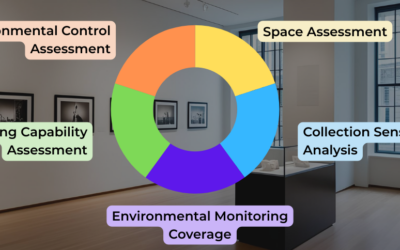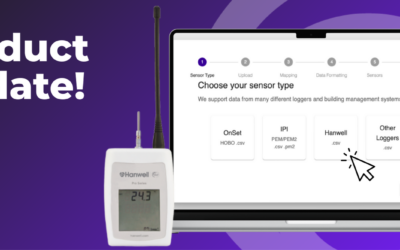At CONSERV we care about collections AND the people who care for collections. In this series of blogs we dive into the stories of some of our favorite customers, what brought them to their current place in their careers, and the unique ways they’re using Conserv.

Dara Lohnes-Davies
The University of Wyoming Art Museum plays a special place in Dara Lohnes-Davies’ heart. It’s the place where her collections career began.
“I didn’t even know this was a field you could get into when I was looking to start out,” she recollected.
She was born into a southern Idaho family who “weren’t museum goers”, but volunteered at her local museum’s planetarium during high school. She originally majored in music education at the University of Wyoming, but her high school experience clenched her a work-study position in her school’s art museum. When she found out she had hearing loss and needed to pivot careers, her supervisor encouraged her to enroll in a new museum studies minor program.
Dara had found her calling.
Dara’s career in museums has taken her around the world and country. She holds a MA in Museum Studies from the University of Leicester. She also worked at the National Music Museum (another Conserv customer) after graduate school. When her undergraduate advisor and work-study supervisor from the University of Wyoming Art Museum retired four years ago, she encouraged Dara to apply for her job as the Collections Manager.
Dara’s career has now come full circle. She gives back to the field through serving in leadership of the Mountain Plains Museum Association Registrars and Collections Managers professional interest group and American Alliance of Museums Collections Stewardship professional network as well as attending other conferences.
Needing More People Power
Dara wears many hats in her current role. “My title is Manager of Collections, but it should also include registrar. If it’s related to the care of objects in the collection, I have a hand in it,” she said. She coordinates incoming and outgoing loans, rotates up to nine galleries three times per year, manages the permanent collection physically and digitally, coordinates with outside conservators, and is the point person for facilities within the university.
The to-do list is neverending, and while there are curators and preparators on the collections team, she’s the only person in a role like hers.
The University of Wyoming Art Museum is small but has an expansive and encyclopedic collection. “We try to collect artworks for students to study that they can’t find anywhere else in Wyoming,” Dara said. Certain collecting areas, such as sculpture and photography, have specific environmental requirements.
Customers using our monitoring tools save an average of 180 hours of work every year. Previously, Dara walked to all twenty of her monitors monthly to manually collect data.
Getting the data itself was time-consuming, and translating it into something she could share with her administrators was even more time-consuming. “It usually took three to four hours to process the information,” she said.
Although she was spending so much time collecting data, what bothered Dara the most was that the data she had reflected conditions from the past month rather than the current moment. “We could only be reactive, rather than proactive,” Dara shared. “Our facilities staff is helpful—but they only have so much power with the equipment that they have, and they manage lots of spaces.”
“Something that’s not twenty years old!”
Dara has been in her position for about four years. She purchased new dataloggers less than a year after she started, inspired by a conference she attended at the Conservation Center for Art & Historic Artifacts (CCAHA) in Philadelphia. Since she had recently invested in new equipment, she wasn’t really looking when she first was asked to forward an informational email about Conserv through her board position at the Mountain Plains Museum Association.
“I felt like I pretty much knew what was out there, and then you guys came out of nowhere!” she said.
Her main consideration was finding “something that wasn’t 20 years old” with technical support available. Her galleries didn’t have reliable WiFi and she wasn’t excited about current Bluetooth solutions. (Conserv doesn’t use either. Find out more about LoRaWAN.)
Initially, she wanted monitors that measured both humidity and temperature with a physical display read-out that she could check each day as she walked by. “If something’s really off, I’m looking at it every day to know if we have an issue.”
The University of Wyoming Museum of Art started with a Conserv trial sensor last June. “If you’re gonna let me try it for free, why not?” Dara quipped. Like any new product, there were some bugs at first, but Dara was able to quickly demonstrate the true value of the reporting features.
“Curators have signed in and said ‘oh, that’s cool’ when they saw how user-friendly the data is,” Dara said. But remote monitoring was the real selling point, especially during the early days of the COVID-19 pandemic. “I kept telling my director when the University was closed that if I could monitor from home, I wouldn’t need to come in as often as I did.”
Dara wanted to upgrade all of her dataloggers to Conserv, but she needed institutional buy-in since she recently purchased new monitors. She worked with Conserv staff to create a cost-saving comparison document. Between the savings in staff time, the easy-to-understand reports, and Dara’s eager sharing at staff meetings about the new IPM features, the administrative team reallocated an endowment for collections funds. Dara was able to replace all of her gallery dataloggers with Conserv products.
Wireless environmental monitoring built for and by museum professionals
Dara discovered over a family dinner that the HOBO sensors she previously used are the same brand of sensors her parents use on their hay farm.
“Agricultural monitors work in our museum, but that’s not what they’re meant to do,” she said. “Conserv is different because you reach out to the museum field and ask us what we want you to make for us.”
She’s been impressed by how easy it’s been to work with Conserv, as well as features such as the light sensors. She’s recommended our products to peers in the field because of how intuitive and user-friendly it is, but her favorite part of the experience is the “vicarious networking.”
“It’s been cool seeing upgrades I haven’t thought of, that someone else has suggested. It gives me insight into what my colleagues are thinking,” she said. She finds that IPM and environmental monitoring are not often the topics of networking conversation, but Conserv’s platform gives her an opportunity to participate in field-wide conversations about environmental monitoring.
Reaching Out and Adapting
Conserv made waves at the University of Wyoming Art Museum because of Dara’s enthusiasm. Her coworkers are accustomed to Dara spending staff meetings exclaiming, “Guess what Conserv’s doing now?”
In a field where there isn’t much adaptation, she’s excited to work with a new company that is responsive to the needs of the field and professionals. No other sensor companies have onboarding programs and regular, proactive communication. Because we see our product as an invested relationship rather than a one-time deal, Dara’s institution has been able to scale up as their needs and collections budget have shifted during this time of great change.
“Keep doing what you’re doing—listening and adapting,” Dara said. “You have a cool opportunity to listen to hundreds of people to make the product meet our needs.”
Every collection is different. Give us a call—we are humans behind the technology. We are excited to geek out about customized solutions for your collections with you! Let’s collaborate and achieve better outcomes for your collections.
If you have any questions about environmental monitoring, integrated pest management, or just want to talk about preventative conservation, please reach out to us! Don’t forget to check out our blog or join our community of collections care professionals where you can discuss hot topics, connect with other conservators or even take a course to get familiar with the Conserv platform.




